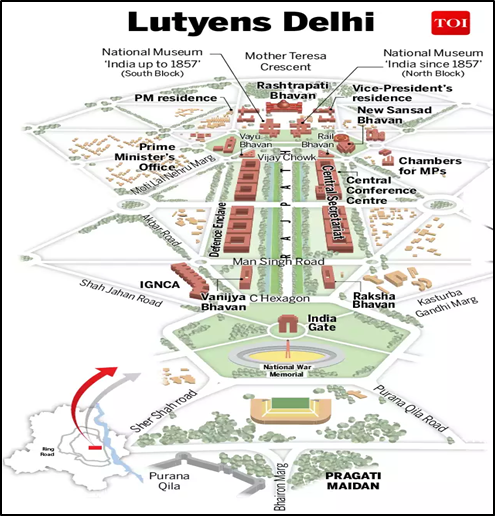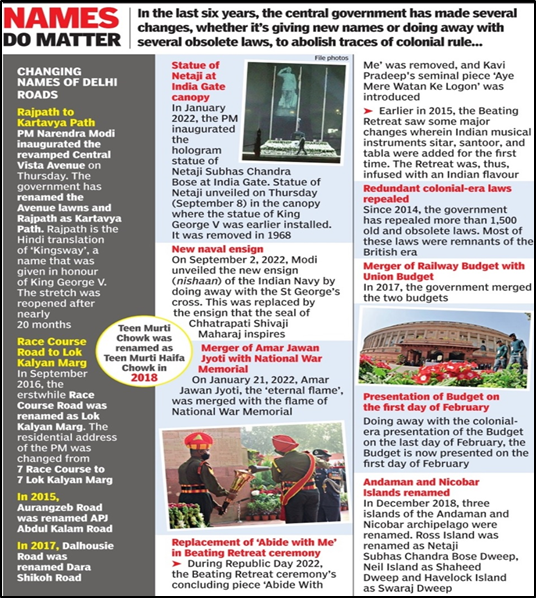In News:
- Recently, PM Modi celebrated the renaming of Rajpath as ‘Kartavya Path’ and installation of the statue of Netaji Subhash Chandra Bose at the India Gate canopy in New Delhi.
What’s in today’s article:
- About Central Vista Project (History, Details, Implementation, etc.)
- About Kartavya Path (History, Significance)
Central Vista Redevelopment Project:

- Central Vista Redevelopment Project refers to the ongoing redevelopment to revamp the Central Vista, India's central administrative area located near Raisina Hill, New Delhi.
- The area was originally designed by Sir Edwin Lutyens and Sir Herbert Baker during British colonial rule and was retained by Government of India after independence.
- In 2019, the Central government announced the redevelopment project to give a new identity to the ‘power corridor’ of India.
- The project aims to –
- Revamp a 3 km long Rajpath (now renamed as Kartavya Path) between Rashtrapati Bhavan and India Gate,
- Convert North and South Blocks to publicly accessible museums by creating a new common Central Secretariat to house all ministries,
- A new Parliament building near the present one with increased seating capacity for future expansion,
- New residence and office for the Vice-President and the Prime Minister near the North Block and South Block and
- Convert some of the older structures into museums.
Implementation:
- The whole project is estimated to cost Rs 20,000 crores.
- Out of this, around Rs 1,000 crores will be used for the construction of a new Parliament.
- The project is estimated to be completed by 2024.
- Nodal Ministry: Ministry of Housing and Urban Affairs
About Kartavya Path:
- In 1911, British government in India decided to move their capital from Calcutta (now Kolkata) to Delhi.
- On 15 December in 1911, King George V and his consort Queen Mary laid the foundation stone of the 'new capital' of the British Raj.
- The plan of a central axis called Kingsway was chalked out by Sir Edwin Lutyens with a view of building a modern imperial city.
- The grand axis was laid from the Great Place (later renamed to Vijay Chowk) to India Gate by the architects.
- Post-independence –
- Soon after India’s independence, Kingsway was renamed to Rajpath and Queensway running perpendicular to it was rechristened as Janpath.
- India then became a Republic on 26th January, 1950, and Rajpath became the venue of all Republic Day celebrations since then.
- Recently, the Rajpath has been renamed to Kartavya Path by the Central government to signify public ownership and empowerment.
- Also, workers involved in the development of the Kartavya Path would be invited as a guest at the next Republic Day Parade.
News Summary:
- Prime Minister Narendra Modi celebrated the renaming of Rajpath as ‘Kartavya Path’ and installation of the statue of Netaji Subhas Chandra Bose at the India Gate canopy as historical milestones towards erasure of colonial domination as well as testimonies to the emergence of India as a resurgent nation.
- He said Kingsway i.e. Rajpath, the symbol of slavery, has become a matter of history from today and has been erased forever. Today a new history has been created in the form of ‘Kartavya Path’.
- Removing all marks of colonial domination was one of the pledges PM Modi during his August 15th address in 2022, to make India a developed nation by 2047.
- Few changes made, in recent years, to abolish the traces of colonial rule can be seen form following diagram:











